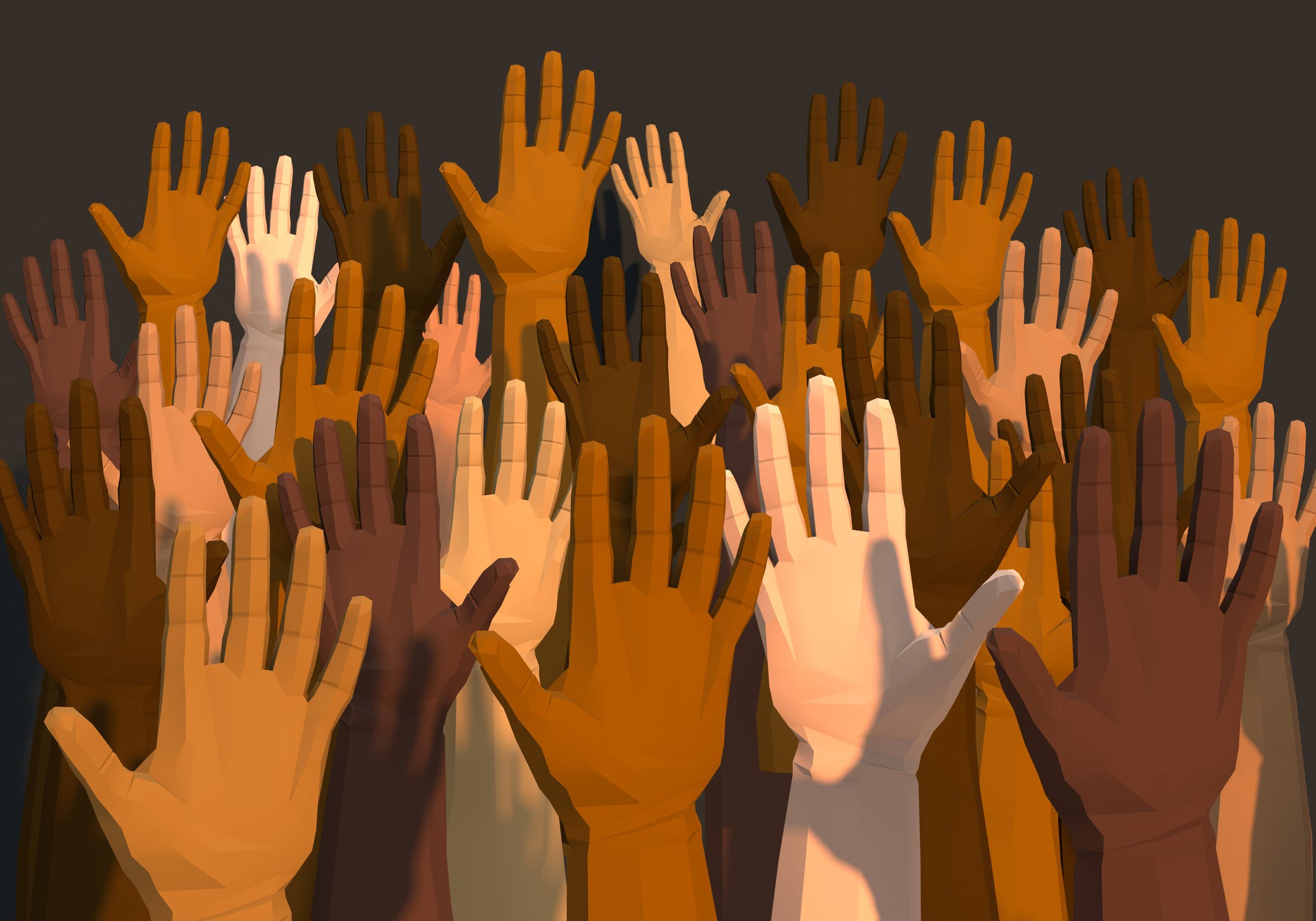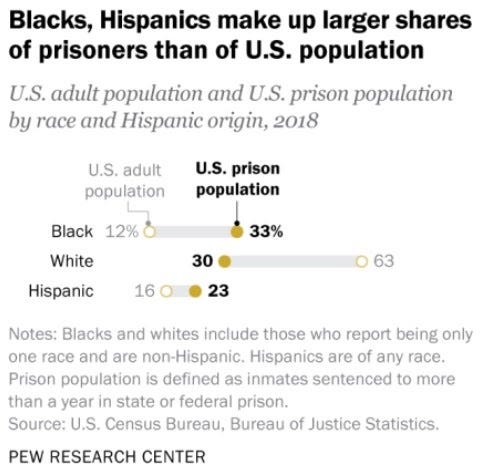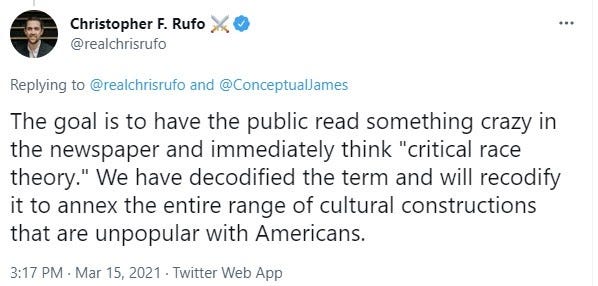1 truth and 3 lies about Critical Race Theory
Today's issue of Popular Information debunks some pernicious myths about Critical Race Theory — a topic that will be a major part of the political discussion for the foreseeable future. The next stage in Popular Information's reporting will be to expose the web of non-profit groups, elected officials, and media figures that are pushing misinformation about Critical Race Theory into American politics. And, critically, it will document the money behind the entire effort. But Popular Information is a two-person operation and this is an enormous project. You can help expand our capacity to do this kind of in-depth research by becoming a paid subscriber. To stay completely independent, Popular Information accepts no advertising. This newsletter only exists because of the support of readers like you. Between now and November 2022, you will be hearing a lot about Critical Race Theory (CRT). On Saturday night, former President Trump bashed CRT during his first rally since leaving the White House. Last week, Senator Ted Cruz (R-TX) introduced the "END CRT Act." In the first two weeks of June, CRT was mentioned 408 times on Fox News. Why has a complex academic legal framework that has been around since the 1980s suddenly become a hot political topic? We don't have to speculate. Right-wing operatives have stated publicly that they plan to use CRT to elect more Republicans. Steve Bannon, who advised Trump in the White House and now hosts an influential podcast on the right, said putting CRT at the center of the political discussion was the key to Republican success in 2022 and beyond:
Trump, Cruz, Bannon, and many other Republicans say that CRT is an insidious force that is being imposed in schools, corporations, and the government. This is how Cruz describes CRT in his new bill.
This is a false description of CRT. (It is also an inaccurate historical description of the Declaration of Independence, which states "all men are created equal." And it was referring only to white men.) But understanding politics in the months ahead will require understanding the truth about CRT — and how CRT is being distorted and manipulated. The truth about Critical Race TheoryAt its heart, Critical Race Theory emerged from a group of legal scholars trying to answer a question: Why, after the Civil Rights Act of 1964 created formal legal equality between racial groups, does substantive racial inequality persist? Let's explore how this works with a concrete example. The United States has the largest prison population in the world. But Black Americans are incarcerated at far greater rates than whites. As of 2018, the latest data available, Blacks represented 12% of the general population and 33% of the prison population. Conversely, whites represent 63% of the general population and 30% of the prison population. Why is there such a stark disparity? One explanation could be that Black Americans commit more crime. The data, however, does not fully support such a conclusion. About a quarter of the prison population is serving time for drug crimes and "[b]lack and white Americans sell and use drugs at similar rates." Nevertheless, Blacks are 2.7 times more likely to be arrested, and more than 6 times more likely to be incarcerated, for drug-related offenses than whites. CRT scholars look at these statistics as evidence of structural racism. Specifically, they seek to identify "laws, policies, and procedures that function to produce racial inequality." In her book, Critical Race Theory: A Primer, Berkeley Law Professor Khiara Bridges details the characteristics of structural racism:
CRT scholars examine the complex ways that the law creates racial inequality through structural racism. For example, the 1996 Supreme Court case of Whren v. United States helps explain how Black Americans are disproportionately arrested and incarcerated for drug crimes. In that case, Michael Whren and his friend, James Brown, were driving when a police officer got a "feeling" that they were engaged in drug-related activity. Under the Fourth Amendment to the Constitution and Supreme Court precedent, however, a police officer cannot stop or search someone based on a "feeling." Depending on the circumstances, the officer would need "probable cause" or "reasonable suspicion" to stop and search the car. So the officers followed the car until they observed it make a turn without signaling. When they pulled over the vehicle, they saw a bag of crack cocaine on Whren's lap and arrested Whren and Brown. A unanimous Supreme Court found the stop and the arrest was legal. CRT scholars note that the ruling effectively allows police to stop any car. If a police officer follows any driver for long enough, they will observe some minor traffic violation, providing a pretext for a stop. Since many people, including police officers, have implicit or explicit biases about the activities of young black men and other minority groups, they will be stopped at higher rates. In this way, a mundane, racially neutral Supreme Court decision helps explain racial inequality in incarceration rates. The purpose of CRT is to understand the structural causes of racial inequality — large and small — in order to dismantle them and create a fairer society. CRT scholars use similar analysis to explain how the law creates racial inequality in health, education, and other areas. Disagreeing with some or all of CRT does not make you a racist. CRT is a lively field of academic study and many CRT scholars disagree with each other. But Chris Rufo, an operative affiliated with the Manhattan Institute who popularized opposition to CRT through frequent appearances on Fox News, acknowledged in March that he is simply using CRT as a vessel to fill with whatever concepts he thinks are politically unpopular. By their own admission, the current crop of CRT critics is not engaged in a good faith argument. They are misrepresenting and distorting CRT for political purposes. Lie #1: CRT is being taught in K-12 schoolsAnyone with a basic understanding of CRT understands that it is not being taught in K-12 schools. The reason is simple: The concepts underlying CRT are generally beyond the scope of undergraduate education, much less elementary school students. A website set up by CRT critics to document "the negative impact Critical Race Training has on education" does not even cover K-12 curriculum because it's "more difficult to track." Nevertheless, "[l]egislators in at least 15 states have introduced measures this session that would prohibit the teaching of critical race theory or related concepts in all publicly funded schools." These bills have been introduced even though there is "no evidence that [CRT] is being taught in any public school." As Matt Gertz notes, there are "are more than 130,000 K-12 schools in the United States." As a result, "it is inevitable that some of them will make decisions that are clumsy, ineffective, unpopular, or all of the above" — especially as they seek to answer students' questions about police shootings, racial justice protests, and other aspects of the modern world. This provides plenty of fodder for Fox News but does mean that CRT is being taught in schools. Lie #2: CRT is about making white people feel guiltySome critics of CRT acknowledge that CRT itself is not being taught in schools but students are being taught concepts derived from CRT. Pundit Andrew Sullivan, for example, says that students are being taught "a whole new epistemology that is directly downstream of academic critical theory." For example, Sullivan claims, schools are teaching "white kids to internalize their complicity in evil." It is possible that, of the millions of white students, someone has been taught that being white makes them "complicit with evil." But this is not CRT. CRT, by contrast, is about how structures — not individuals — create racial inequality and injustice. "According to most definitions of institutional racism, actors — be they good, bad, or indifferent — are irrelevant in the grand scheme of things, as they play a minuscule role in something much bigger than themselves," Bridges explains, "Undeniably, individuals animate these institutions. But the fault lies not with the individual actors who bring institutions to life." CRT is not about making white people feel guilty. It's an argument that racial inequality is the product of something bigger than discrete individual action. Lie #3: CRT is about defining people based on their raceCruz's bill asserts that CRT stands for the idea that white people are "inherently flawed." This isn't true. CRT scholars, in fact, believe that race is a social construct and not a biological entity. They believe there is nothing "natural" about racial categories and, therefore, nothing "inherently" flawed or good about being a white person or Black person. They are artificial categories that society constructed. As a result, CRT scholars reject the idea that inequalities between races can be explained through genetics. (This view is also supported by the Human Genome Project, which found that 99.9% of all human's genetics are the same and the small differences are not distributed along racial lines.) But CRT scholars also reject the idea that you can fix these inequalities by ignoring race. Rather, CRT scholars believe the racial hierarchy has to be acknowledged in order to be dismantled. Chief Justice Roberts famously wrote that the "way to stop discrimination on the basis of race is to stop discriminating on the basis of race." CRT scholars, according to Bridges, believe there is a difference "between thinking about race in order to maintain the dominance of a racial group and thinking about race in order to empower a subordinated racial group." CRT embraces "race consciousness in the service of racial justice." But, CRT teaches, we should be aware of racial inequality not because people of different races are inherently different, but because they are the same. |
Older messages
What happens next on voting rights
Thursday, June 24, 2021
On Wednesday, all 50 Senate Republicans voted to filibuster the For the People Act, a sweeping election reform bill that would thwart state efforts to suppress voting. The Republican opposition could
These companies can't quit Mo Brooks
Wednesday, June 23, 2021
There were 147 Republicans who voted to overturn the election on January 6. But Mo Brooks is in a category of his own. The Alabama Congressman, who has launched a campaign for US Senate, spoke at the
What corporate PACs are doing 6 months after the attack on the Capitol
Monday, June 21, 2021
Shortly after the January 6 attack on the Capitol, which was motivated by Trump's lies about election fraud, Comcast — the parent company of NBC Universal — released the following
How to pull back the curtain on secret corporate political spending
Thursday, June 17, 2021
Currently, corporations in the United States are able to keep much of their political spending secret. So what the public knows about the influence of corporations on the political system is woefully
Trump attempted a coup. Now there are emails that prove it.
Wednesday, June 16, 2021
After he lost the election, Trump attempted a coup to keep himself in power. Trump hasn't been successful — but his no-holds-barred effort to overturn the election continues.
You Might Also Like
Volunteer DEF CON hackers dive into America's leaky water infrastructure [Mon Nov 25 2024]
Monday, November 25, 2024
Hi The Register Subscriber | Log in The Register Daily Headlines 25 November 2024 water Volunteer DEF CON hackers dive into America's leaky water infrastructure Six sites targeted for security
EndHunger_FinalForReal.docx
Monday, November 25, 2024
The G20 have a new plan, again what happened last week in Asia, Africa and the Americas Hey, this is Sham Jaff, your very own news curator. Each week, I highlight some of the biggest stories from
The House Just Blessed Trump’s Authoritarian Playbook by Passing Nonprofit-Killer Bill
Monday, November 25, 2024
Democratic support for the bill dwindled as critics warned it would let Donald Trump crack down on political foes. Most Read The House Just Blessed Trump's Authoritarian Playbook by Passing
Monday Briefing: U.N. climate talks end with a deal
Sunday, November 24, 2024
Plus, photographing the world's food. View in browser|nytimes.com Ad Morning Briefing: Asia Pacific Edition November 25, 2024 Author Headshot By Gaya Gupta Good morning. We're covering a deal
GeekWire's Most-Read Stories of the Week
Sunday, November 24, 2024
Catch up on the top tech stories from this past week. Here are the headlines that people have been reading on GeekWire. ADVERTISEMENT GeekWire SPONSOR MESSAGE: Get your ticket for AWS re:Invent,
13 Things That Delighted Us Last Week: From Daschund Bags to Sparkly Toilet Seats
Sunday, November 24, 2024
Plus, the Gucci poker set that Jennifer Tilly packs in her carry-on. The Strategist Logo Every product is independently selected by editors. If you buy something through our links, New York may earn an
LEVER WEEKLY: Trump's Cabinet Of Curiosities
Sunday, November 24, 2024
Opening up Trump's corruption-riddled cabinet and more from The Lever this week. LEVER WEEKLY: Trump's Cabinet Of Curiosities By The Lever • 24 Nov 2024 View in browser View in browser This is
What our travel expert brings on every trip
Sunday, November 24, 2024
M&Ms? View in browser Ad The Recommendation Ad Traveling is stressful for everyone, even travel writers Various travel gear items laid out on a yellow background. Michael Hession/NYT Wirecutter
☕ The Brew’s Holiday Gift Guide
Sunday, November 24, 2024
What to get everyone in your family... Presented By Bose November 24, 2024 | View Online | Sign Up | Shop Sunny Eckerle NOTE FROM THE WRITERS Good morning! Cassandra and Matty here, Morning Brew's
How Friendsgiving became America's favorite made-up holiday
Sunday, November 24, 2024
Plus: The real story behind FX's "Say Nothing," the horrifying effects of air pollution in South Asia, and more. November 25, 2024 View in browser Friendsgiving is just what America




